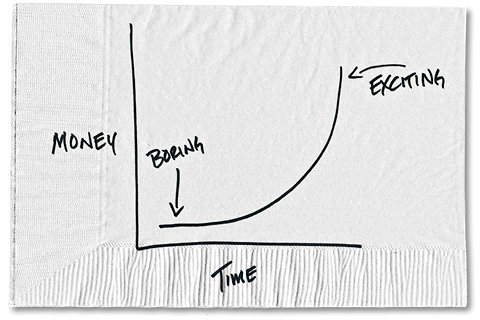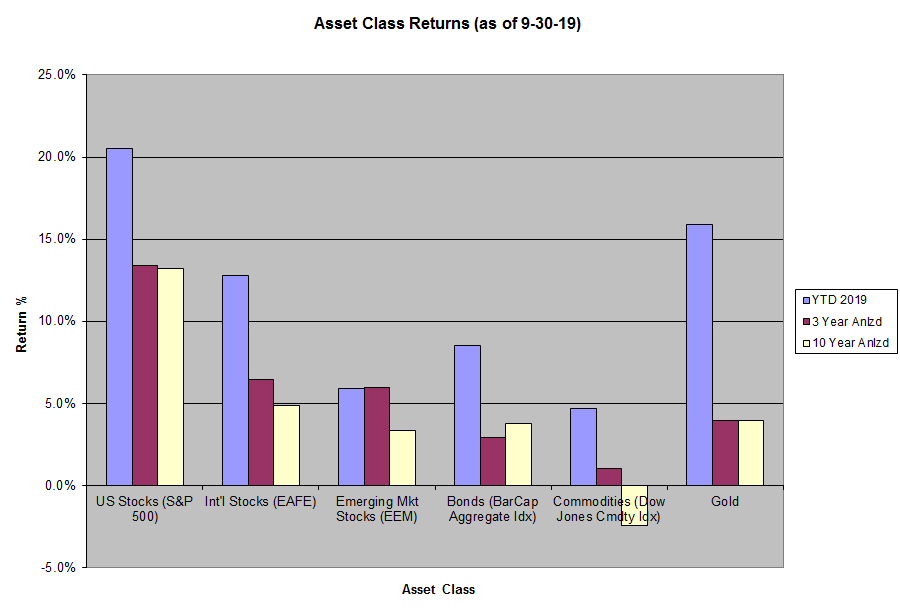AMM 4th Quarter 2019 Client Letter
Investing is by default a boring exercise. Buying a stock and checking the share price 4 times a day to see how much money you are making (or not) might be fun, but it’s not investing. Investing requires patience and a willingness to delay gratification. That’s the whole point, foregoing immediate pleasure/consumption for a long term gain in overall wealth.
Today, delayed gratification is ever more difficult given that we are inundated on a regular basis with solicitations to buy this or that. Social media seems to have exacerbated this problem by promoting a glamorized picture of other people living their best lives – for a price. More than ever, investing requires a sound temperament to battle all of the noise.
Famed value investor Seth Klarman, author of the value investing tome Margin of Safety, famously said “The single greatest edge an investor can have is a long-term orientation”. Margin of Safety has been out of print for many years, but is available on Amazon for $1330. You don’t need to pay up for Klarman’s wisdom though. The accompanying graph tells you all you need to know.
Think Like an Owner
Investment by definition equals ownership. Interestingly, for many people their most successful investment is their primary residence. Since we don’t naturally think of our place of residence as an investment asset, but rather a home, we tend not to worry about the ups and downs of the real estate market. Homes are also not very liquid and it is costly to “trade” them. There is no daily quote of the home’s price so less of a chance that we will freak out and sell in a downturn.
So most of us go about our lives living in and hopefully enjoying our home – but not really focusing on our home as an investment. Then lo and behold at some point way off in the future we look back and realize our home is worth 2, 3 maybe 4 times the price we paid. Between inflation, population growth, and region specific circumstances like supply constraints, homes generally have a price tailwind over the very long-run. Most homeowners benefit from this tailwind because they have a long-term orientation.
Small and mid-sized business owners also generally have a long-term orientation. Most small business owners establish their businesses to provide themselves with a job and primary source of income. They aren’t investing in the business to trade it for another any time soon. Some may casually look at what comparable businesses sell for, but in most instances small business owners are busy working on their business day to day and not thinking about their business as an investment.
There is significant risk of failure in starting a small business. But for owners whose businesses survive, it may very well end up being the biggest and most successful investment of their lives. Like the homeowner, this success will stem in part from the fact that the business owner has a long-term orientation.
Stocks represent owner interests in businesses and bonds represent creditor interests in businesses. Stocks are a very long-dated asset in that they have no maturity date. Therefore an investor in stocks should have a long-time horizon to match the lifecycle of the business. But for some reason, when it comes to investing in the capital markets would be investors take on a very short-term orientation. For the average investor the results are dismal (see Exhibit A below).

Source: J.P. Morgan Asset Management; Dalbar Inc. Average asset allocation investor return is based on analysis by Dalbar Inc., which utilizes the net of aggregate mutual fund sales, redemptions and exchanges each month as a measure of investor behavior. Returns are annualized (and total return where applicable) and represent the 20-year period ending 12/31/18 to match Dalbar’s most recent analysis.
This shouldn’t be the case. The United States has the deepest and most liquid capital markets in the world. We also have a hard fought system of regulations and property rights designed to protect investors, arguably making our markets the safest in the world. Add to this the fact that it is easier than ever to invest. Gone are the days of high commissions – or even any commissions, and publicly available information is easier and cheaper than ever to access. It should follow that investors in these markets should do very well over time.
But something seems to go wrong for the average investor when they tip their toes in to the capital markets. Faced with daily price quotes, information overload from traditional and financially focused media sources, and long-term plans quickly disintegrate in to dangerous short termism. Fear of a pending “market crash” or “recession” causes investors to sell otherwise sound investments or avoid investing until given the all clear signal by the market. However the all clear signal only comes after prices have already risen. On the flip side, after prices have risen a dangerous “fear of missing out” mindset can take hold, causing investors to buy speculative investments at any price in the sheer hope that they will keep going up.
At AMM we work hard to remember these behavioral miscues, as they affect the professional and individual investor alike. We seek to think and invest like owners. We view the portfolios that we build as collections of enduring businesses as opposed to pieces of paper to be traded frequently based on the news of the day. Most importantly we seek to maintain a long-term orientation.
Year-to-Date Review and Outlook
Through 9/30/19, domestic stocks (S&P 500) increased 20.6%, developed international stocks (EAFE) increased 12.8%, and emerging market stocks (EM) were up 5.9%. Bonds (Bar Cap Agg Idx) increased 8.5%, commodities (DJ Comm Idx) increased 4.7%, and gold increased 15.9%. We have updated our asset class return chart below.
Economist and financial historian Peter Bernstein once described risk as meaning “more things can happen than will happen”. It is dangerous to invest based on what you think will happen in markets since this implies certain predictive powers that no one has. Our 5th core principle “no one can predict the future” reminds us that investing is not about predicting the future but about understanding today. Understanding today is no small feat, especially in a world of trade-wars, real wars, political polarization, etc. But it is infinitely more achievable than consistently winning at the roulette wheel.
Today there is a lot of talk about a potential for a recession. The Fed’s own model predicts a greater than 30% chance of recession over the next 12 months. Domestic markets are trading at fair values assuming a rosy economic outcome, but may look very expensive in the event of a significant recession. We are also more than 10 years on in to this upswing in the economic cycle, and while there is no set date for cycle expiration it is hard to argue that we are in the early stages. In baseball parlance, our best estimate is that we are in the 7th or 8th inning. But we can’t be sure.
Against this backdrop we continue to view today as a time for a marginally reduced risk posture. This doesn’t mean dramatically selling down stock exposure, especially for client’s with long time horizons, but it has meant that we are generally underweight domestic stocks relative to our long-term targets in our asset allocation strategies. For more conservative investors and those with shorter-time horizons, we are holding above average positions in conservative shorter-term bonds and/or cash alternatives. There are risks to this posture, notably that if domestic markets do very well over the coming year, our clients will likely participate but not as much if we were taking a more aggressive posture.
However based on our assessment of the current environment, we feel that this is a reasonable trade-off. Of course we continue to reassess the environment and will make adjustments to our positioning as warranted to help our clients meet their investment objectives.
*Individual accounts will vary based on a client’s stated objectives, risk tolerance and time frame. We manage several different portfolio strategies, so not every client has exposure to the securities, asset classes or investment strategies discussed above. In addition to growth and/or income oriented asset allocation strategies, we also manage more concentrated equity portfolios that generally carry a higher degree of risk and volatility.
Should you have any questions regarding your investment account(s) and personal financial plans, or if there have been any recent changes to your investment and/or retirement objectives, please do not hesitate to contact our office to speak with one of us at your convenience.
As always, we thank you for entrusting AMM to help you achieve your investment and retirement objectives.
Your Portfolio Management Team





